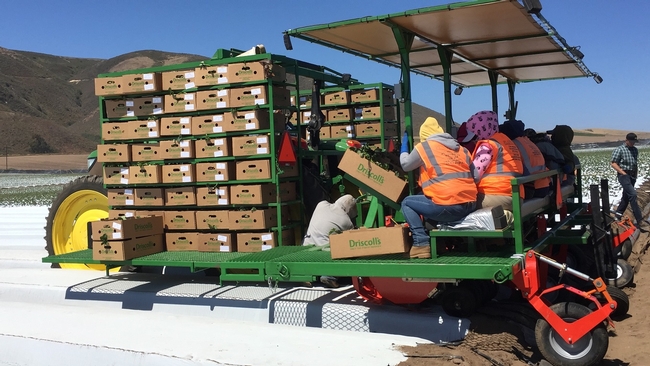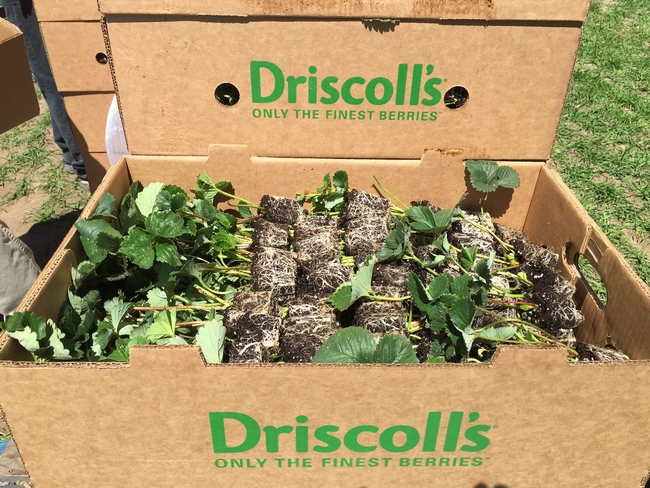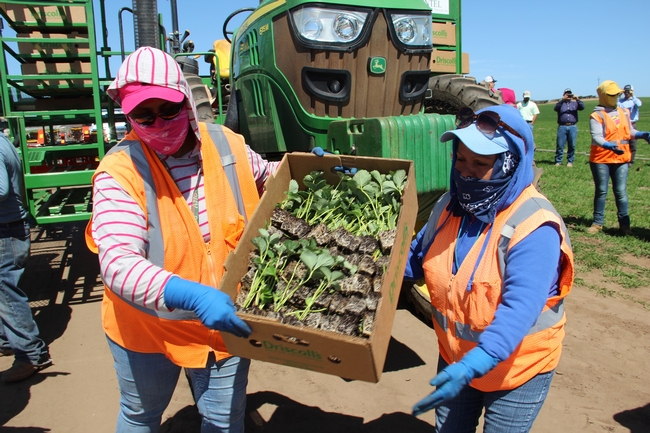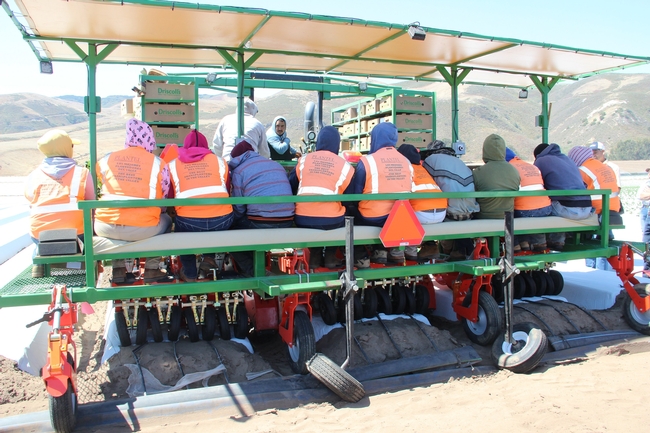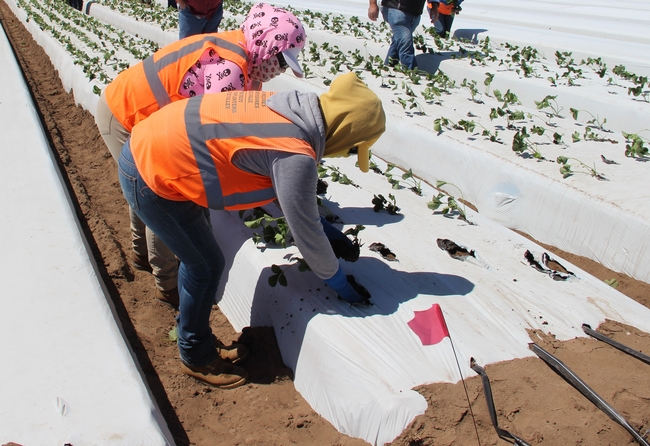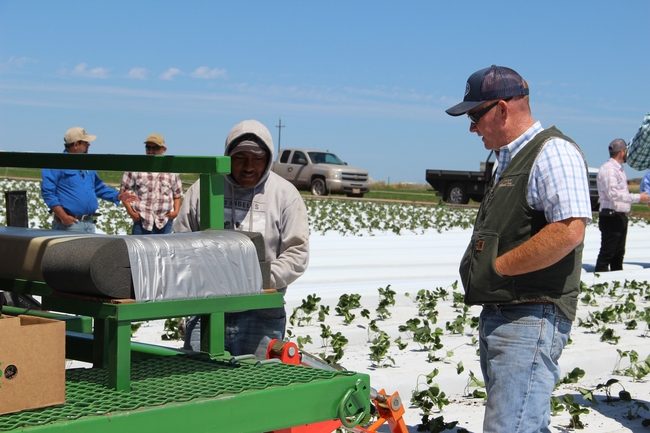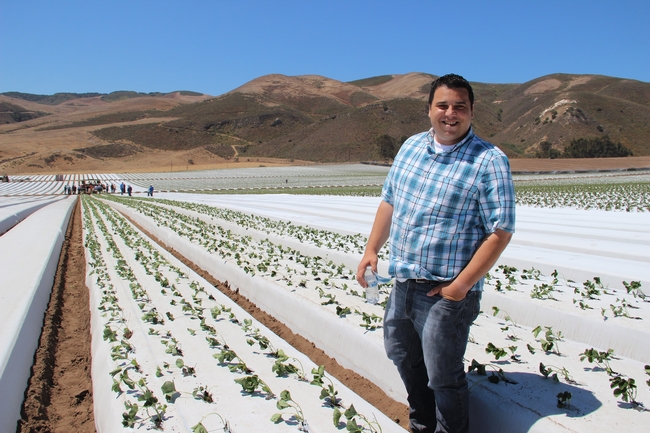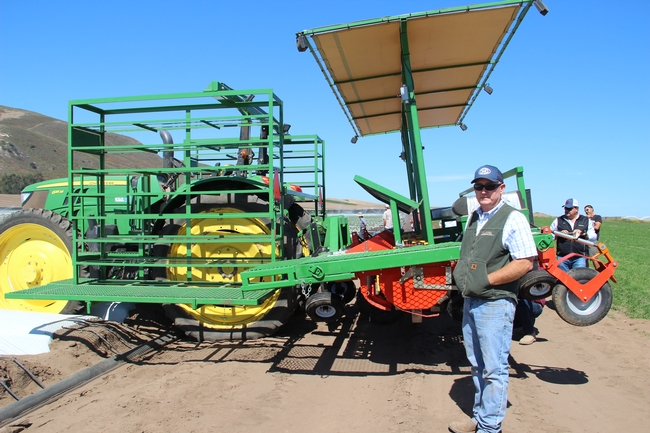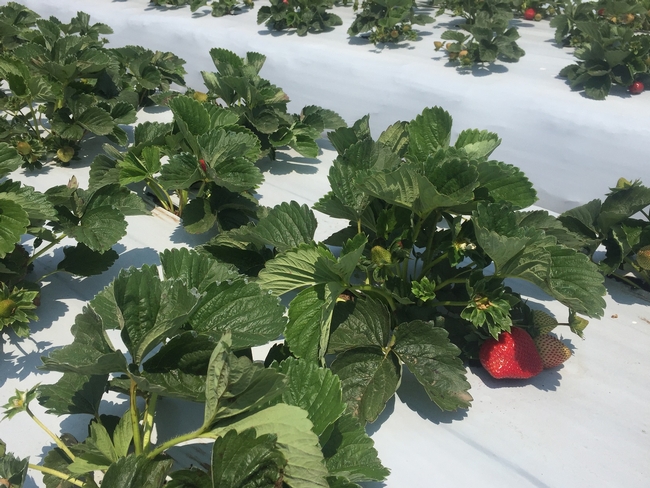Mechanical strawberry transplanter, the first of its kind in California, developed from collaboration among Driscoll's, Plantel, and Solex. (Photo by Surendra Dara)
Strawberry is one of those crops with high input costs and labor is one of the major expenses in strawberry production. Both nursery and fruit production operations require a high volume of manual labor for planting, tending to the plants, processing of transplants or harvesting fruits. Shortage of skilled farmworkers is a major challenge that strawberry industry is currently facing and it is even a bigger problem for summer planting when help is also needed for fruit harvesting from previous year's fall plantings. Driscoll's, known as the largest berry producer in the world, developed a strawberry transplanter, which is a significant advancement in mechanization of transplanting, one of the two major manual operations in the strawberry production.
Driscoll's team demonstrated their 3-bed transplanter to some growers on June 20, 2016 in an organic strawberry field in the Santa Maria area. Chris Jenkins, Product Specialist at Driscoll's conceived the idea and worked with Chris Waldron at Plantel Nurseries and Matt Phillips at Solex in developing the first mechanical strawberry transplanter. Tim McDonald at Guadalupe Hardware also helped in this development. They experimented first with their 1-bed transplanter in Februrary, 2016 using celery transplants, which were grown to represent the strawberry transplants that would be available in June. In the meantime, they developed a 3-bed transplanter in the next few months. On June 10, Driscoll's planted 10 acres of strawberries using their new 3-bed transplanter. The bulk of the misted tips are being propagated locally in standard nursery greenhouses in Nipomo.
The Italian manufacture, Checchi e Magli built the original transplanter that is modified by Driscoll's, Plantel Nurseries, and Solex for strawberries. “We took the Italian machine used for transplanting peppers and other crops in mulch and modified it for strawberries,” said Chris Waldron. “It costs about $46,000 for the transplanter units that cover three beds. With the tractor, racks, seating, and other equipment, the total cost could be about $120,000 for the entire unit.”
Misted tip strawberry transplants locally grown in greenhouses in Nipomo. (Photo by Surendra Dara)
Crew loading the transplant trays. (Photo by Surendra Dara)
It is estimated that when planting a traditional bare root transplant, 10 farmworkers (including a plant distributor, a forklift driver, and a crew boss) are required to work an eight hour day to transplant one acre of acre of strawberry, which typically has 28,000 plants for a 4-row/bed configuration. The mechanical transplanter can plant 10 acres in a day with the help of a 19-member crew, which includes the tractor driver, a plant handler/loader, 12 planters (one per each plant line loading the transplants into the planting slots), and five people checking the transplanted plants on the bed. What used to take 100 people to manually transplant 10 acres can now be done with just 19 people. “Harvesting crew members get about $30/hour and putting them on a transplanting job with about $10/hour is not ideal,” said Chris Jenkins. “With the help of this machine, we can now engage the farmworkers in a high paying job. It is socially, economically, and ergonomically a big improvement and helps our field crew tremendously. As the transplanter does most of the work, it will allow the available labor to focus on harvesting fresh market strawberries that fetch a higher price than processing strawberries. But one point I would like to highlight is that we are not displacing jobs with the machine. Generally, no one wants to do the transplanting job when harvesting is obviously the preferred job.”
A 12-member team feeds the transplants (above) while two members check on the beds and ensure that all plants are in a good condition. (Photos by Surendra Dara)
Chris Waldron (Plantel Nurseries) instructing a crew member who is verifying the plants. (Photo by Surendra Dara)
Happy and proud Chris Jenkins (Driscoll's) standing in a newly transplanted field (above) and Chris Waldron (Plantel Nurseries) in front of the mechanical strawberry transplanter (below) (Photos by Surendra Dara)
Some of the advantages of the mechanical transplanter include:
- Efficient and uniform transplanting that requires less time and manpower.
- Avoidance of human errors in planting depth, j-roots, and other such issues in manual planting of bare root transplants.
- Misted tip transplants actively growing and are not dormant like bare root transplants. They are also in an advanced growth stage compared to bare root transplants and will likely start fruit production 2-3 weeks earlier than the latter.
- Once separated from the mother plants, it takes about 6 weeks for the misted tip transplants, while several months of field production and refrigeration are required for bare root transplants.
- Local production of misted tip transplants is more likely to adjust to grower needs and probably has a better control over producing uniform and good quality transplants that can be easily supplied without long distance transportation.
- It is less likely to have soilborne diseases from misted tip transplants compared to the bare root transplants from a traditional infield nursery.
About 7 weeks after transplanting, strawberry plants look healthy and already started producing fruit (Photo by Chris Jenkins, Driscoll's)
According to Chris Jenkins, fruit yields from misted tip transplants were nearly twice as much as the yields from bare root plants in their 2015 study. Uniform planting, better plant health, and early fruit production could have contributed to higher yields from the misted tip plants.
Development of the strawberry transplanter is a major improvement to the strawberry production technology with a significant contribution to the labor shortage issue.
